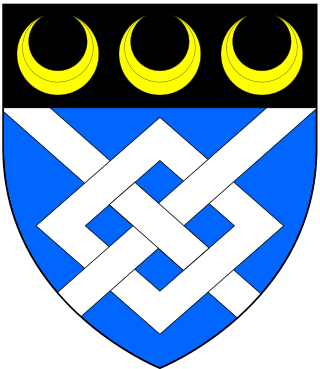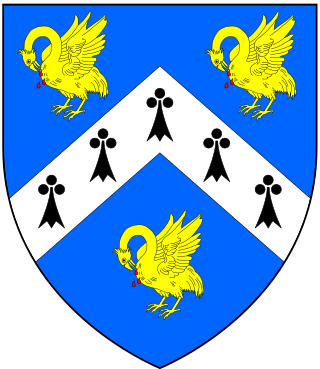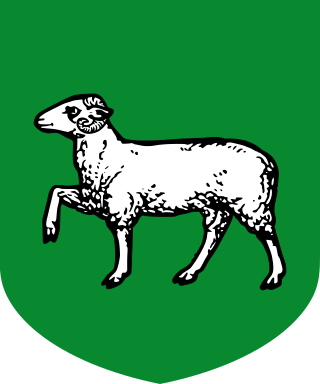
Alexander Fuller-Acland-Hood, 1st Baron St Audries PC, known as Sir Alexander Fuller-Acland-Hood, Bt, until 1911, was a British Conservative Party politician. He served as Parliamentary Secretary to the Treasury under Arthur Balfour from 1902 to 1905.
The Bannerman Baronetcy, of Elsick in the County of Kincardine, is a title in the Baronetage of Nova Scotia. It was created on 28 December 1682 for Alexander Bannerman. The eleventh Baronet was a pioneer military aviator. The twelfth Baronet was a soldier and courtier.

There have been two baronetcies created for persons with the surname Head, one in the Baronetage of England and one in the Baronetage of the United Kingdom. One creation is extant as of 2007.

The Stracey baronetcy, of Rackheath in the county of Norfolk, is a title in the baronetage of the United Kingdom. It was created on 15 December 1818 for Edward Stracey. He was the eldest surviving son of Sir John Stracey, chief judge of the Sheriff's Court and a recorder of London.
The Peacocke Baronetcy, of Grange in the County of Limerick and of Barntinck in the County of Clare, was a title in the Baronetage of the United Kingdom. It was created on 24 December 1802 for Sir Joseph Peacocke, of Grange, County Limerick. Sir Joseph was the son of George Peacocke Esq. and his wife Mary (Levett) Peacocke, daughter of Joseph Levett, Alderman, of Cork, Ireland. The title became extinct on the death of his grandson, the third Baronet, in 1876.

Charles Murray, 1st Earl of Dunmore PC was a British peer, previously Lord Charles Murray.

The Cullum baronetcy, of Hastede in Suffolk, was created in the Baronetage of England on 18 June 1660 for Thomas Cullum. It became extinct on the death of the eighth Baronet, 26 January 1855. The family estate was Hardwick House, Suffolk.
The Goldney Baronetcy, of Beechfield in the Parish of Corsham and Bradenstoke Abbey in the Parish of Lyneham, both in the County of Wiltshire, was a title in the Baronetage of the United Kingdom. It was created on 11 May 1880 for Gabriel Goldney, Conservative Member of Parliament for Chippenham. The title became extinct on the death of the fourth Baronet in 1974.
Sir John Parnell, 1st Baronet, was an Irish politician and a baronet.

The Yea baronetcy, of Pyrland in the County of Somerset, was a title in the Baronetage of Great Britain. It was created on 18 June 1759 for William Yea, who was High Sheriff of Somerset in 1760. The title became extinct on the death of the third Baronet in 1864.

The Milnes baronetcy, of Gauley in the County of Leicester, was a title in the Baronetage of the United Kingdom. It was created on 21 March 1801 for the colonial governor Robert Milnes. The title became extinct on the death of the invalid second Baronet in 1839, the only surviving son, "after many years in delicate and precarious health" residing at Sydling.

Sir John Henry Seale, 1st Baronet (1780–1844) of Mount Boone in the parish of Townstal near Dartmouth in Devon, was a Whig Member of Parliament for Dartmouth in 1838. He was created a baronet on 31 July 1838. He owned substantial lands in Devon, mainly at Townstal and Mount Boone. Together with the Earl of Morley of Saltram House near Plymouth, he built several bridges in Dartmouth, most notably the Dart crossing. Arthur Howe Holdsworth's, the previous Member of Parliament in Dartmouth, influence over the pocket borough of Dartmouth ceased after the 1832 Reform Act and subsequently he was in competition for that parliamentary seat with John Seale, who won the seat.
Sir Alexander Bannerman, 6th Baronet was a Scottish medical doctor and professor of medicine at the University of Aberdeen.

The Palmer Baronetcy, of Carlton in the County of Northampton, was created in the Baronetage of England on 7 June 1660 for the lawyer and politician Geoffrey Palmer. The second Baronet was Member of Parliament for Higham Ferrers. The third, fourth and fifth Baronets all represented Leicestershire in the House of Commons. The fifth Baronet served as High Sheriff of Leicestershire in 1782 and the eighth Baronet as High Sheriff of Northamptonshire in 1871.

The Buller baronetcy, of Churston Court, Devon, was created in the Baronetage of Great Britain on 13 January 1790 for Francis Buller. The second baronet assumed by Royal licence the surname of Yarde in 1800. The third baronet, Sir John Yarde-Buller, was created Baron Churston in 1858, with which title the baronetcy remains merged.

The Hood baronetcy, of Tidlake in the County of Surrey, was created in the Baronetage of the United Kingdom on 13 April 1809 for Admiral Samuel Hood (1762–1814). He was a younger son of Samuel Hood (1715–1805) of Kingsland in the parish of Netherbury, Dorset, a purser in the Royal Navy and first cousin of the 1st Viscount Hood and the 1st Viscount Bridport. The baronetcy was created with remainder to his nephew Alexander Hood (1793–1851) of Wootton House, Butleigh, Somerset, and the heirs male of his body.
Captain Sir George Ferdinand Radziwill Forestier-Walker, 2nd Baronet JP DL was a British soldier.

The Blackwood baronetcy, of the Navy, was created in the Baronetage of the United Kingdom on 1 September 1814 for the Honourable Henry Blackwood, seventh son of Sir John Blackwood, 2nd Baronet and of Dorcas Blackwood, 1st Baroness Dufferin and Claneboye. He was a Vice-Admiral of the Blue in the Royal Navy and was the bearer of despatches announcing the victory of Trafalgar in 1805. The 7th Baronet succeeded as 10th Baron Dufferin and Claneboye and 11th Baronet of Killyleagh in 1988.

The Hamilton baronetcy, of Trebinshun House in the County of Brecon, was created in the Baronetage of the United Kingdom on 26 January 1819 for the naval commander Admiral Sir Edward Hamilton. He was the younger son of Sir John Hamilton, 1st Baronet, of Marlborough House. His grandson the 2nd Baronet succeeded as the 4th baronet of Marlborough House in 1892, and the titles merged. Both baronetcies became extinct in 2008.

The Acland Baronetcy, of Colum John in the County of Devon, was created in the Baronetage of England on 24 June 1644 for John Acland, a supporter of Charles I. The letters patent were then lost in the confusion of the Civil War.














